Samsung Electronics Co SGHH128 PCS GSM/EDGE USB Modem User Manual D DONGGLE FCC SGH H128 IME
Samsung Electronics Co Ltd PCS GSM/EDGE USB Modem D DONGGLE FCC SGH H128 IME
Users Manual

World Wide Web
http://www.samsungmobile.com
Printed in Korea
Code No.:GH68-xxxxxA
English. 07/2008. Rev. 1.0
Some of the contents in this manual may differ from your device depending on
the software of the device or your service provider.

SGH-H128
user manual
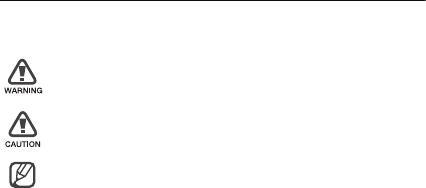
Instructional icons
Before you start, familiarise yourself with the icons you will see in this
manual:
Warning
—situations that could cause injury to yourself or
others
Caution
—situations that could cause damage to your
device or other equipment
Note
—notes, usage tips, or additional information

1
contents
safety and usage information 4
Safety warnings ............................................................................ 4
Safety precautions ........................................................................ 6
Important usage information ......................................................... 8
introducing your dongle 9
Unpack ........................................................................................ 9
Dongle layout ............................................................................. 10
Install the USIM card .................................................................. 11
Insert a memory card (optional) .................................................. 12
Connect the dongle to your PC .................................................. 13
Install the USB driver .................................................................. 14
Check the USB driver ............................................................14
Install the connection manager program ..................................... 15

2
contents
using functions 16
Run the connection manager program ....................................... 16
From the Start menu .............................................................. 16
From the desktop .................................................................. 16
Use the tray icon ........................................................................ 17
Connect to the Internet ............................................................... 17
Use message functions .............................................................. 18
Create and send a text message ............................................ 18
Check messages ................................................................... 19
Find a message .....................................................................20
Create a new folder ................................................................20
Export or import messages .................................................... 21
Use Phonebook functions .......................................................... 21
Add a new contact ................................................................. 21
Find a contact ........................................................................ 22
Export or import contacts ...................................................... 22
Use a removable disk ................................................................. 23

3
contents
customising your dongle 24
Costomise the settings ...............................................................24
Set general settings ...............................................................24
Configure Internet settings ..................................................... 24
Change the network ............................................................... 25
Check configured networks ................................................... 25
Set sound settings ................................................................. 26
Lock the USIM card ...............................................................26
Change the PIN ..................................................................... 26
Check information .................................................................. 27
View the online help .................................................................... 27
troubleshooting 28
Frequently asked questions ........................................................ 28
About the device and services ............................................... 28
About the connection manager program ................................ 30
Warranty and parts replacement ................................................. 32

4
safety and usage
information
Comply with the following precautions to avoid dangerous or illegal situations
and ensure peak performance of your device.
Keep your device away from small children and pets
Keep your device and all accessories out of the reach of small children
or animals. Small parts may cause choking or serious injury if
swallowed.
Safety warnings

5
safety and usage information
Handle and dispose of devices with care
• Never dispose of the device in a fire. Follow all local regulations
when disposing used devices.
• Never place your device on or in heating devices, such as
microwave ovens, stoves, or radiators. Devices may explode when
overheated.
• Never crush or puncture the device. Avoid exposing the device to
high external pressure, which can lead to an internal short circuit
and overheating.
Turn off the device in potentially explosive
environments
Do not use your device at refuelling points (service stations) or near
fuels or chemicals. Turn off your device whenever directed by warning
signs or instructions. The device could cause explosions or fire in and
around fuel or chemical storage and transfer areas or blasting areas.
Do not store or carry flammable liquids, gases, or explosive materials in
the same compartment as the device, its parts, or accessories.
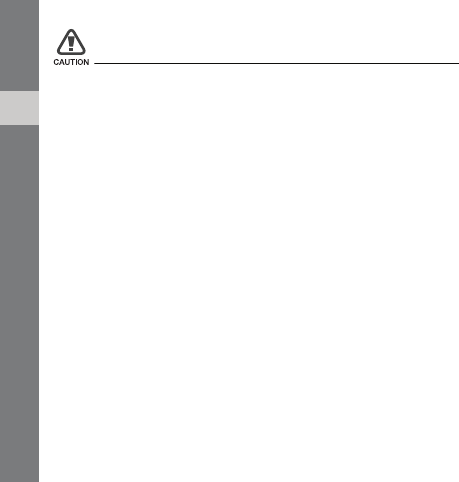
6
safety and usage information
Drive safely at all times
Avoid using your device while driving and obey all regulations that
restrict the use of devices while driving.
Follow all safety warnings and regulations
Comply with any regulations that restrict the use of a device in a certain
area.
Use only Samsung-approved accessories
Using incompatible accessories may damage your device or cause
injury.
Turn off the device near medical equipment
Your device can interfere with medical equipment in hospitals or health
care facilities. Follow all regulations, posted warnings, and directions
from medical personnel.
Turn off the device or disable the wireless functions
when in an aircraft
Your device can cause interference with aircraft equipment. Follow all
airline regulations and turn off your device or switch to a mode that
disables the wireless functions when directed by airline personnel.
Safety precautions

7
safety and usage information
Protect the device from damage
Avoid exposing devices to very cold or very hot temperatures (below
0° C/32° F or above 45° C/113° F). Extreme temperatures can reduce
the charging capacity and life of your devices.
Handle your device carefully and sensibly
• Do not allow your device to get wet—liquids can cause serious
damage. Do not handle your device with wet hands. Water damage
to your device can void your manufacturer’s warranty.
• Avoid using or storing your device in dusty, dirty areas to prevent
damage to moving parts.
• Your device is a complex electronic device—protect it from impacts
and rough handling to avoid serious damage.
• Do not paint your device, as paint can clog moving parts and
prevent proper operation.
• Your device and memory cards may be damaged by exposure to
magnetic fields. Do not use carrying cases or accessories with
magnetic closures or allow your device to come in contact with
magnetic fields for extended periods of time.
Avoid interference with other electronic devices
Your device emits radio frequency (RF) signals that may interfere with
unshielded or improperly shielded electronic equipment, such as
pacemakers, hearing aids, medical devices, and other electronic
devices in homes or vehicles. Consult the manufacturers of your
electronic devices to solve any interference problems you experience.
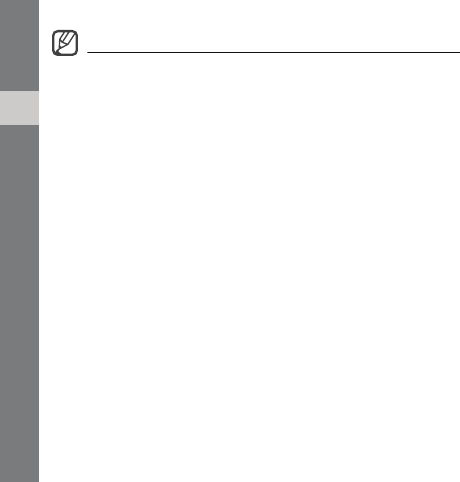
8
safety and usage information
Allow only qualified personnel to service your device
Allowing unqualified personnel to service your device may result in
damage to your device and will void your warranty.
Handle USIM cards and memory cards with care
• Do not remove a card while the device is transferring or accessing
information, as this could result in loss of data and/or damage to the
card or device.
• Protect cards from strong shocks, static electricity, and electrical
noise from other devices.
• Frequent writing and erasing will shorten the life span of memory
cards.
• Do not touch gold-colored contacts or terminals with your fingers or
metal objects. If dirty, wipe the card with a soft cloth.
Important usage information

9
introducing your
dongle
Learn about your dongle’s layout and get started by connecting to a PC.
Unpack
Check your product box for the following items:
•USB Dongle
•User manual
•Y-cable
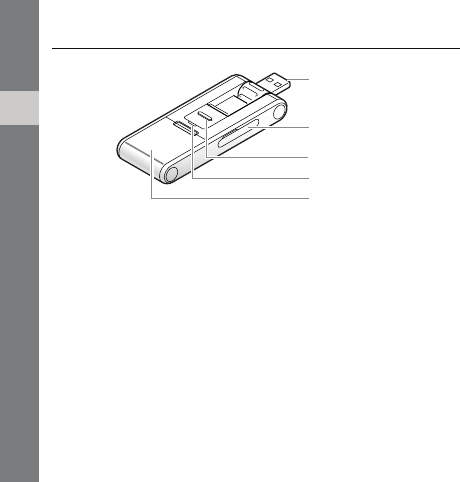
10
introducing your dongle
Dongle layout
Status light
USB
connector
USB cover
Memory card
slot
SIM cover
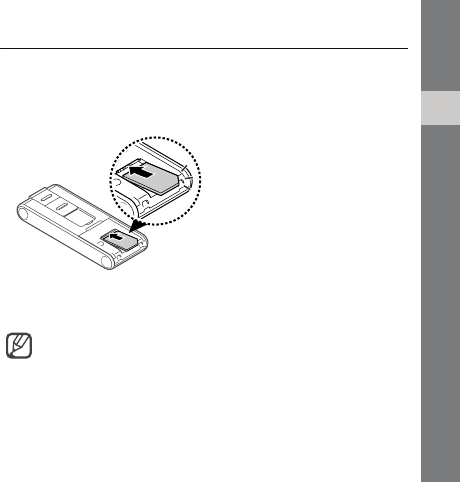
11
introducing your dongle
Install the USIM card
When you subscribe to service, you will receive a Universal Subscriber
Identity Module or USIM card, with subscription details, such as your
personal identification number (PIN) and optional services.
Remove the SIM cover and insert the USIM card.
• To prevent someone using your USIM card when it is stolen
or lost, you can lock the card. See page 26.
• To purchase a USIM card or subscribe to a network,
contact your service provider.
Place the USIM card in the dongle with the gold-coloured contacts
facing down.
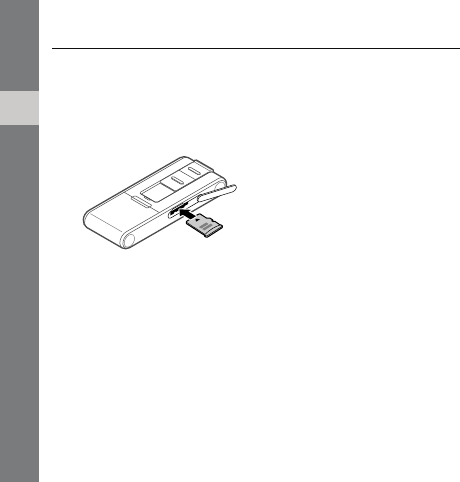
12
introducing your dongle
Insert a memory card (optional)
To store additional multimedia files, you must insert a memory card.
Your dongle accepts microSD™ memory cards up to 4 GB
(depending on memory card manufacturer and type).
1. Open the cover to the memory card slot on the side of the dongle.
2. Insert a memory card with the label side facing up.
3. Push the memory card in the memory card slot until it locks in
place.
To remove the memory card, push it gently until it disengages from the
dongle, and then pull the memory card out of the memory card slot.

13
introducing your dongle
Connect the dongle to your PC
1. Slide open the USB cover until it locks in place and rotate the USB
connector.
2. Connect the dongle to a USB port on a PC.
The status light blinks, and then becomes solid blue. Now the
dongle is ready to be used.
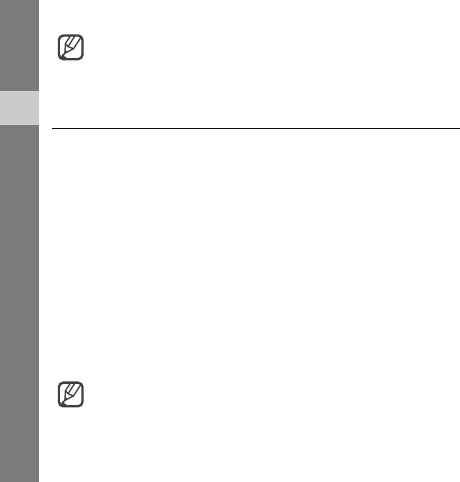
14
introducing your dongle
Install the USB driver
1. Connect the dongle to a USB port on a PC.
When connected, an InstallShield Wizard window will appear on
the PC.
2. Click [Install Driver].
3. Click [Install] (if necessary, click [Browse] to change the destination
folder).
4. When the installation is finished, click [OK].
Check the USB driver
Click [Start] and select [Settings] → [Control Panel] → [System] →
[Hardware] → [Device Manger].
When the USB driver is successfully installed, you can check the name
of the dongle on the Device Manager window.
Connect the USB connector to the USB port carefully. Forcing
the connector to the wrong way may damage the USB
connector or USB port.
If you need to reinstall the USB driver, double-click the
Setup.exe file saved in the destination folder (default folder:
c:\Program\Connection Manager\Driver\).
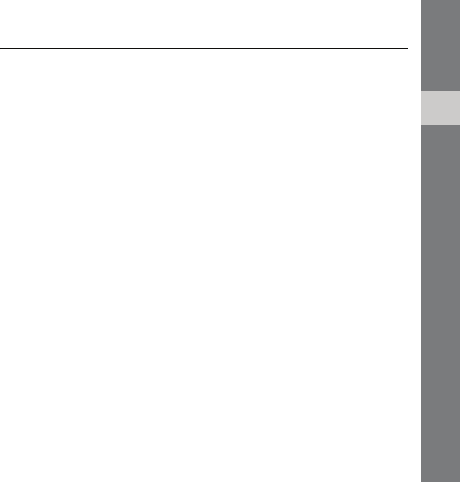
15
introducing your dongle
Install the connection manager program
1. Connect the dongle to a USB port on a PC.
When connected, an InstallShield Wizard window will appear on
the PC.
2. Click [Install Connection Manager].
3. Click [Next].
4. Click [Next] (if necessary, click [Browse] to change the destination
folder).
5. Click [Next] to begin installing the connection manager program.
6. When the installation is finished, click [Close].

16
using functions
Learn how to perform operations and use the features of your dongle.
Run the connection manager program
From the Start menu
Click [Start] and select [All programs] → [Samsung Connection
Manager].
The main window of the connection manager program opens.
From the desktop
Double-click the [Connection Manager] icon on the desktop.
The main window of the connection manager program opens.
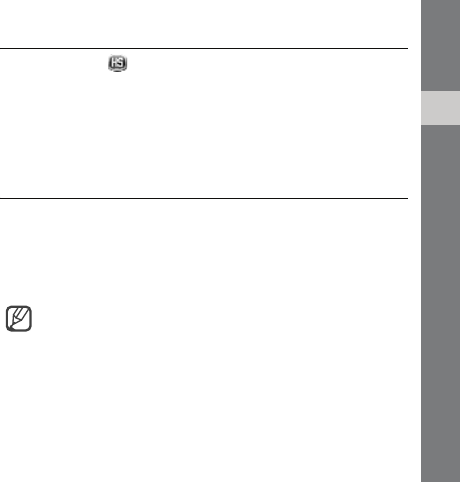
17
using functions
Use the tray icon
1. Right click the icon in the notification area.
2. Select the menu you want.
•Open: open the connection manager program
•Mass storage: open the memory disk
•Exit: exit the connection manager program
Connect to the Internet
Click [Connect] in the main window to connect to the Internet using the
HSDPA network.
You can check information about the current network connection in the
main window.
To end the connection with the Internet, click [Disconnect].
The WAP (Wireless Application Protocol) browser is not
supported.
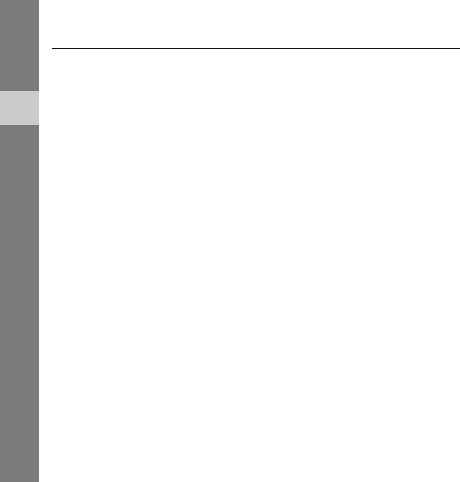
18
using functions
Use message functions
Send text messages and view the received messages. The EMS
(Enhanced Messaging Service) and multimedia messages are not
supported.
Create and send a text message
1. Click [Text message] in the main window.
2. Click [Create].
3. Enter the message text.
4. Enter phone numbers in the recipients list.
• Click [Phonebook] to retrieve phone numbers from Phonebook.
• Click [Recent contacts] to retrieve numbers from the recent
contact list.
5. Click [Send] to send the message.
• Click [Send options] to set up options for sending text
messages.
• Click [Save Draft] to send the message later.
• Click [Close] to cancel the message composition.

19
using functions
Check messages
Access messages you have received, sent, or saved to send at a later
time.
To view the messages you have received:
1. Click [Text message] in the main window.
2. Click [Inbox] from USIM or PC.
3. Check the message you want.
To view the messages you have sent:
1. Click [Text message] in the main window.
2. Click [Sendbox] from USIM or PC.
3. Check the message you want.
To view the messages that has failed to be sent or you have
saved to send at a later time:
1. Click [Text message] in the main window.
2. Click [Drafts] or [Outbox] from USIM or PC.
3. Check the message you want.

20
using functions
Find a message
1. Click [Text message] in the main window.
2. Enter the first few letters of the message you want to find in the
search field and click .
3. Select the message on the search list.
• Click [Reply] to reply to the sender.
• Click [Forward] to forward the message to other people.
• Click [Move] to move the message to any folder.
• Click [Delete] to delete the message.
Create a new folder
Create new folders and organise messages.
To create a new folder:
1. Click [Text message] in the main window.
2. Right click [My folders] from PC and select [Create folder].
3. Enter the folder name and click [OK].
To move a message to the new folder, select it and click [Move].

21
using functions
Export or import messages
Export messages stored in the PC or SIM card. Also, import message
to the PC or SIM card.
To export messages:
1. Click [Text message] in the main window.
2. Select messages you want to export and click [Export].
3. Select a location where messages are stored and enter a file
name.
4. Click [Save].
To import messages:
1. Click [Text message] in the main window.
2. Click [Import].
3. Select a file to be imported and click [Open].
Use Phonebook functions
Store phone numbers and search for them in Phonebook.
Add a new contact
1. Click [Phonebook] in the main window.

22
using functions
2. Click [New].
3. Enter contact information.
4. Click [Save] to add the contact.
Find a contact
1. Click [Phonebook] in the main window.
2. Enter the first few letters of the name you want to find at the top
right of the window and click .
3. Select the contact name on the search list and check the contact
information.
• Click [Write] to send a text message to the selected contact.
• Click [Edit] to edit the selected contact.
• Click [Copy/Move] to copy or move the selected contact.
• Click [Delete] to delete the selected contact.
Export or import contacts
Export contacts stored in the PC in digital files. Also, import contacts
stored as digital files to the PC.
To export contacts:
1. Click [Phonebook] in the main window.
2. Select contacts you want to export and click [Export].
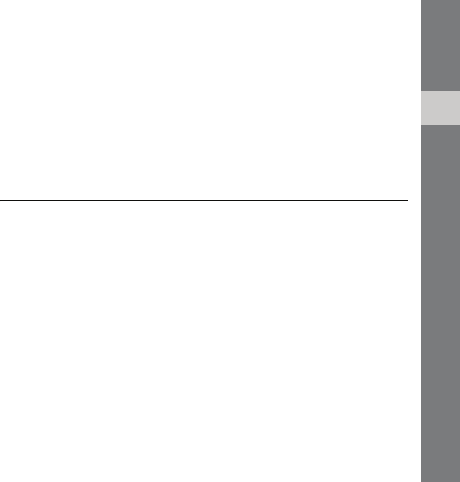
23
using functions
3. Select a location where contacts are stored and enter a file name.
4. Click [Save].
To import contacts:
1. Click [Phonebook] in the main window.
2. Click [Import].
3. Select a CSV file to be imported and click [Open].
Use a removable disk
Use the dongle as an external memory disk to access the folder
directory.
1. When the dongle is connected to the PC, a pop-up window will
appear on the PC.
2. Select [Open folder to view files] in the pop-up window.
3. Copy files from the PC to the memory disk, or vice versa.
Click [Mass storage] in the main window to use the inserted
memory card.

24
customising your
dongle
Get more from your dongle by customising it to match your preferences.
Costomise the settings
Customise various settings to use the program.
Set general settings
1. Click [Settings] in the main window.
2. Select the options you want.
Configure Internet settings
Select a profile or enter information to connect to the Internet.
1. Click [Settings] in the main window.
2. Click the [Internet] tab.

25
customising your dongle
3. Select a profile from the drop-down list.
Or, click [New], enter information you have received from your
service provider, and click [Save].
Change the network
Change the network (if necessary). If you select the wrong network,
your dongle may not work correctly.
1. Click [Settings] in the main window.
2. Click the [Network] tab.
• Select [Auto] or a network band from Network mode.
• Select [Auto] or [Manual] from Network selection for available
networks.
If you select [Manual], click [Search] and double-click the
network you want to connect.
Check configured networks
Check networks configured by your service provider.
1. Click [Settings] in the main window.
2. Click the [Pre Network] tab.
3. Select a network.
• Click [New] to configure a new network profile.

26
customising your dongle
Set sound settings
1. Click [Settings] in the main window.
2. Click the [Sound] tab.
3. Select an alert tone for each event.
Lock the USIM card
Lock the USIM card to keep it safe from unauthorised use. You must
enter PIN (Personal Identification Number) to connect to the Internet
when the USIM card is locked.
1. Click [Settings] in the main window.
2. Click the [USIM PIN] tab.
3. Select [Lock] from PIN Lock settings.
4. Enter the current PIN.
Change the PIN
Change the PIN that is used to lock or unlock the USIM card.
1. Click [Settings] in the main window.
2. Click the [USIM PIN] tab.
3. Enter the current PIN in Enter current PIN.
4. Enter a new PIN in Enter new PIN.
5. Enter the new PIN again in Confirm new PIN and click [Change].
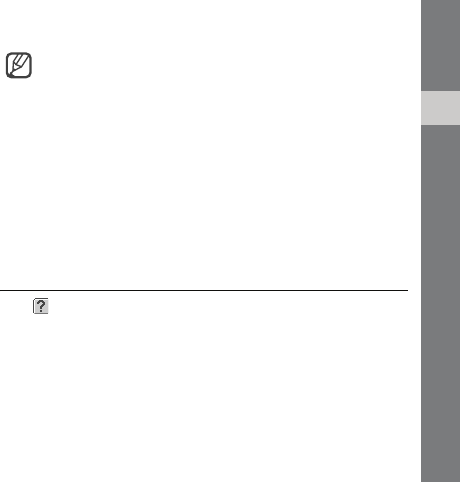
27
customising your dongle
6. Click [Yes] to confirm.
Check information
1. Click [Settings] in the main window.
2. Click the [Information] tab.
• Check information about the dongle and the connection
manager program.
• Click [Reset] to clear the records of sent and received date.
View the online help
Click in the main window.
If you enter an incorrect PIN three times, the USIM card is
blocked. To unlock it, you need to enter your PUK (Personal
Unblocking Key). The codes are supplied by your service
provider.

28
troubleshooting
If you are having trouble with your dongle, try these troubleshooting
procedures before contacting a service professional.
Frequently asked questions
About the device and services
Will my dongle work without a USIM card?
No. You must insert a USIM card to use the dongle.

29
troubleshooting
Is it okay to insert another type of USIM card when using the
dongle?
No. The dongle only works with the USIM card provided by your
service provider. It will not work with other USIM cards.
Why won’t my computer recognise my USB devices when I plug
two of them together?
The computer cannot recognise two devices at the same time.
Connect and disconnect USB device one at a time.
Can I connect the dongle to a printer or fax?
You must connect the dongle to a PC. Then, you can use a printer or
fax that is also connected to the PC.
Will the dongle work with my PC operating system?
The dongle will work on Windows 2000/XP/Vista.

30
troubleshooting
About the connection manager program
Will I still receive messages when the modem is offline?
Yes, but you cannot view those messages until you reconnect the
modem. When you connect the modem to your PC, you can view any
messages that have been received within the last 24 hours.
The program disappeared while I was using it.
You may have accidentally minimised or closed the program. If your
taskbar shows the HSDPA Connection Manager icon, double-click it to
restore the program. Otherwise, launch the program again.
How can I avoid losing the data on my USIM card?
If you disconnect the dongle from your PC while the device is on, you
may lose the data on your USIM card. First, exit the connection
manager program, then check the status light on the dongle. If the light
is off, it is safe to disconnect it from the PC.
I entered the wrong PIN a few times. Why can't I use my device
anymore?
If you enter the wrong PIN three times, your USIM card locks
automatically. To unlock the card, you must enter a PUK, which you
can get from your service provider.
If you enter the wrong PUK ten times, the USIM card will no
longer work.

31
troubleshooting
Can I connect to the Internet using Dial-up Networking?
No. You must use a wireless connection to access the Internet.
How many messages or contacts can I save on my USIM card?
The number of messages or contacts you can save depends on the
type of USIM card you use. When you fill the card's memory, new
messages or contacts will be saved on your PC.
Can I make voice calls with the connection manager program?
No. The connection manager program does not support voice calls.
Can I use SIM Application Toolkit menus?
No. The connection manager program and the dongle do not support
SIM Application Toolkit menu.
Can I register my USIM card using a configuration message?
No. You cannot register your USIM card using a configuration
message.
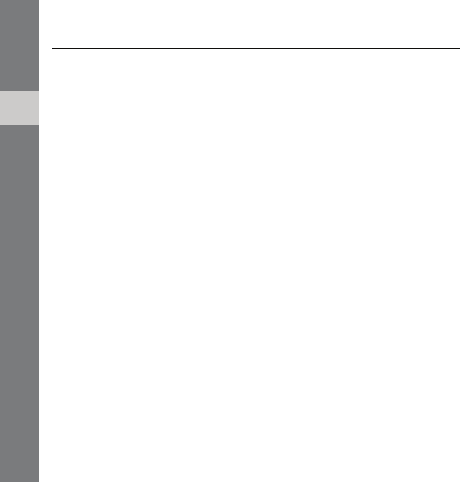
32
troubleshooting
Warranty and parts replacement
Samsung warrants this product as free of defects in material, design
and workmanship for the period of one year from the original date of
purchase. (Depending on your country or service provider, the length
of warranty may vary.)
If during the period of warranty this product proves defective under
normal use and service you should return the product to the retailer
from whom it was originally purchased or qualified service centre. The
liability of Samsung and its appointed maintenance company is limited
to the cost of repair and/or replacement of the unit under warranty.
• The warranty is limited to the original purchaser
• A copy of your receipt or other proof of purchase is required for a
proper warranty service
• The warranty is void if the serial number, date code label or product
label is removed, or if the product has been subject to physical
abuse, improper installation modification, or repair by unauthorised
third parties
• Specifically exempt from any warranty are limited-life consumable
components such as batteries and other accessories
• Samsung will not assume any responsibility for any loss or damage
incurred in shipping. All repair work on Samsung products by
unauthorised third parties voids any warranty

52
Health and safety information
Exposure to Radio Frequency (RF) Signals
Certification Information (SAR)
Your wireless USB dongle is a radio transmitter and
receiver. It is designed and manufactured not to exceed
the exposure limits for radio frequency (RF) energy set
by the Federal Communications Commission (FCC) of
the U.S. government. These FCC exposure limits are
derived from the recommendations of two expert
organizations, the National Counsel on Radiation
Protection and Measurement (NCRP) and the Institute
of Electrical and Electronics Engineers (IEEE). In both
cases, the recommendations were developed by
scientific and engineering experts drawn from industry,
government, and academia after extensive reviews of
the scientific literature related to the biological effects
of RF energy.
The exposure limit set by the FCC for wireless mobile
USB dongles employs a unit of measurement known as
the Specific Absorption Rate (SAR). The SAR is a
measure of the rate of absorption of RF energy by the
human body expressed in units of watts per kilogram
(W/kg). The FCC requires wireless USB dongles to
comply with a safety limit of 1.6 watts per kilogram (1.6
W/kg). The FCC exposure limit incorporates a
substantial margin of safety to give additional
protection to the public and to account for any
variations in measurements.
SAR tests are conducted using standard operating
positions accepted by the FCC with the USB dongle
transmitting at its highest certified power level in all
tested frequency bands. Although the SAR is
determined at the highest certified power level, the
actual SAR level of the USB dongle while operating can
be well below the maximum value. This is because the
USB dongle is designed to operate at multiple power
levels so as to use only the power required to reach the
network. In general, the closer you are to a wireless
base station antenna, the lower the power output.
Before a new model USB dongle is available for sale to
the public, it must be tested and certified to the FCC

53
that it does not exceed the exposure limit established
by the FCC. Tests for each model USB dongle are
performed in positions and locations (e.g. at the ear
and worn on the body) as required by the FCC.
The highest SAR values for this model USB dongle as
reported to the FCC are: GSM1900 Body: 1.45 W/Kg.
For body worn operation, this model USB dongle has
been tested and meets the FCC RF exposure guidelines
whenused with a Samsung accessory designated for
this product or when used with an accessory that
contains no metal and that positions the USB dongle a
minimum of 0.5 cm from the body.
Non-compliance with the above restrictions may result
in violation of FCC RF exposure guidelines.
SAR information on this and other model USB dongles
can be viewed on-line at www.fcc.gov/oet/fccid. This
site uses the USB dongle FCC ID number,
A3LSGHH128 Sometimes it may be necessary to
remove the battery pack to find the number. Once you
have the FCC ID number for a particular USB dongle,
follow the instructions on the website and it should
provide values for typical or maximum SAR for a
particular USB dongle. Additional product specific SAR
information can also be obtained at www.fcc.gov/cgb/
sar.
Consumer Information on Wireless USB
dongles
The U.S. Food and Drug Administration (FDA) has
published a series of Questions and Answers for
consumers relating to radio frequency (RF) exposure
from wireless USB dongles. The FDA publication
includes the following information:
What kinds of USB dongles are the subject of
this update?
The term wireless USB dongle refers here to hand-held
wireless USB dongles with built-in antennas, often
called “cell,” “mobile,” or “PCS” USB dongles. These
types of wireless USB dongles can expose the user to
measurable radio frequency energy (RF) because of the
short distance between the USB dongle and the user's
head. These RF exposures are limited by Federal
Communications Commission safety guidelines that
were developed with the advice of FDA and other

Health and safety information
54
federal health and safety agencies. When the USB
dongle is located at greater distances from the user, the
exposure to RF is drastically lower because a person's
RF exposure decreases rapidly with increasing distance
from the source. The so-called “cordless USB dongles,”
which have a base unit connected to the teleUSB dongle
wiring in a house, typically operate at far lower power
levels, and thus produce RF exposures well within the
FCC's compliance limits.
Do wireless USB dongles pose a health
hazard?
The available scientific evidence does not show that any
health problems are associated with using wireless USB
dongles. There is no proof, however, that wireless USB
dongles are absolutely safe. Wireless USB dongles emit
low levels of radio frequency energy (RF) in the
microwave range while being used. They also emit very
low levels of RF when in the stand-by mode. Whereas
high levels of RF can produce health effects (by heating
tissue), exposure to low level RF that does not produce
heating effects causes no known adverse health effects.
Many studies of low level RF exposures have not found
any biological effects. Some studies have suggested
that some biological effects may occur, but such
findings have not been confirmed by additional
research. In some cases, other researchers have had
difficulty in reproducing those studies, or in determining
the reasons for inconsistent results.
What is FDA's role concerning the safety of
wireless USB dongles?
Under the law, FDA does not review the safety of
radiation-emitting consumer products such as wireless
USB dongles before they can be sold, as it does with
new drugs or medical devices. However, the agency has
authority to take action if wireless USB dongles are
shown to emit radio frequency energy (RF) at a level
that is hazardous to the user. In such a case, FDA could
require the manufacturers of wireless USB dongles to
notify users of the health hazard and to repair, replace
or recall the USB dongles so that the hazard no longer
exists.
Although the existing scientific data do not justify FDA
regulatory actions, FDA has urged the wireless USB
dongle industry to take a number of steps, including the
following:
55
• “Support needed research into possible biological
effects of RF of the type emitted by wireless USB
dongles;
• “Design wireless USB dongles in a way that
minimizes any RF exposure to the user that is not
necessary for device function; and
• “Cooperate in providing users of wireless USB
dongles with the best possible information on
possible effects of wireless USB dongle use on
human health.
FDA belongs to an interagency working group of the
federal agencies that have responsibility for different
aspects of RF safety to ensure coordinated efforts at the
federal level. The following agencies belong to this
working group:
• “National Institute for Occupational Safety and
Health
• “Environmental Protection Agency
• “Federal Communications Commission
• “Occupational Safety and Health Administration
• “National Telecommunications and Information
Administration
The National Institutes of Health participates in some
interagency working group activities, as well.
FDA shares regulatory responsibilities for wireless USB
dongles with the Federal Communications Commission
(FCC). All USB dongles that are sold in the United
States must comply with FCC safety guidelines that
limit RF exposure. FCC relies on FDA and other health
agencies for safety questions about wireless USB
dongles.
FCC also regulates the base stations that the wireless
USB dongle networks rely upon. While these base
stations operate at higher power than do the wireless
USB dongles themselves, the RF exposures that people
get from these base stations are typically thousands of
times lower than those they can get from wireless USB
dongles. Base stations are thus not the primary subject
of the safety questions discussed in this document.
What are the results of the research done
already?

Health and safety information
56
The research done thus far has produced conflicting
results, and many studies have suffered from flaws in
their research methods. Animal experiments
investigating the effects of radio frequency energy (RF)
exposures characteristic of wireless USB dongles have
yielded conflicting results that often cannot be repeated
in other laboratories. A few animal studies, however,
have suggested that low levels of RF could accelerate
the development of cancer in laboratory animals.
However, many of the studies that showed increased
tumor development used animals that had been
genetically engineered or treated with cancer-causing
chemicals so as to be pre-disposed to develop cancer in
absence of RF exposure. Other studies exposed the
animals to RF for up to 22 hours per day. These
conditions are not similar to the conditions under which
people use wireless USB dongles, so we don't know with
certainty what the results of such studies mean for
human health.
Three large epidemiology studies have been published
since December 2000. Between them, the studies
investigated any possible association between the use
of wireless USB dongles and primary brain cancer,
glioma, meningioma, or acoustic neuroma, tumors of
the brain or salivary gland, leukemia, or other cancers.
None of the studies demonstrated the existence of any
harmful health effects from wireless USB dongles RF
exposures. However, none of the studies can answer
questions about long-term exposures, since the
average period of USB dongle use in these studies was
around three years.
What research is needed to decide whether RF
exposure from wireless USB dongles poses a
health risk?
A combination of laboratory studies and epidemiological
studies of people actually using wireless USB dongles
would provide some of the data that are needed.
Lifetime animal exposure studies could be completed in
a few years. However, very large numbers of animals
would be needed to provide reliable proof of a cancer
promoting effect if one exists. Epidemiological studies
can provide data that is directly applicable to human
populations, but ten or more years' follow-up may be
needed to provide answers about some health effects,
such as cancer. This is because the interval between the
time of exposure to a cancer-causing agent and the
57
time tumors develop - if they do - may be many, many
years. The interpretation of epidemiological studies is
hampered by difficulties in measuring actual RF
exposure during day-to-day use of wireless USB
dongles. Many factors affect this measurement, such as
the angle at which the USB dongle is held, or which
model of USB dongle is used.
What is FDA doing to find out more about the
possible health effects of wireless USB dongle
RF?
FDA is working with the U.S. National Toxicology
Program and with groups of investigators around the
world to ensure that high priority animal studies are
conducted to address important questions about the
effects of exposure to radio frequency energy (RF).
FDA has been a leading participant in the World Health
Organization international Electromagnetic Fields (EMF)
Project since its inception in 1996. An influential result
of this work has been the development of a detailed
agenda of research needs that has driven the
establishment of new research programs around the
world. The Project has also helped develop a series of
public information documents on EMF issues.
FDA and Cellular Telecommunications & Internet
Association (CTIA) have a formal Cooperative Research
and Development Agreement (CRADA) to do research
on wireless USB dongle safety. FDA provides the
scientific oversight, obtaining input from experts in
government, industry, and academic organizations.
CTIA-funded research is conducted through contracts to
independent investigators. The initial research will
include both laboratory studies and studies of wireless
USB dongle users. The CRADA will also include a broad
assessment of additional research needs in the context
of the latest research developments around the world.
What steps can I take to reduce my exposure
to radio frequency energy from my wireless
USB dongle?
If there is a risk from these products - and at this point
we do not know that there is - it is probably very small.
But if you are concerned about avoiding even potential
risks, you can take a few simple steps to minimize your
exposure to radio frequency energy (RF). Since time is

Health and safety information
58
a key factor in how much exposure a person receives,
reducing the amount of time spent using a wireless USB
dongle will reduce RF exposure.
• “If you must conduct extended conversations by
wireless USB dongle every day, you could place
more distance between your body and the source of
the RF, since the exposure level drops off
dramatically with distance. For example, you could
use a headset and carry the wireless USB dongle
away from your body or use a wireless USB dongle
connected to a remote antenna.
Again, the scientific data do not demonstrate that
wireless USB dongles are harmful. But if you are
concerned about the RF exposure from these products,
you can use measures like those described above to
reduce your RF exposure from wireless USB dongle use.
What about children using wireless USB
dongles?
The scientific evidence does not show a danger to users
of wireless USB dongles, including children and
teenagers. If you want to take steps to lower exposure
to radio frequency energy (RF), the measures described
above would apply to children and teenagers using
wireless USB dongles. Reducing the time of wireless
USB dongle use and increasing the distance between
the user and the RF source will reduce RF exposure.
Some groups sponsored by other national governments
have advised that children be discouraged from using
wireless USB dongles at all. For example, the
government in the United Kingdom distributed leaflets
containing such a recommendation in December 2000.
They noted that no evidence exists that using a wireless
USB dongle causes brain tumors or other ill effects.
Their recommendation to limit wireless USB dongle use
by children was strictly precautionary; it was not based
on scientific evidence that any health hazard exists.
Do hands-free kits for wireless USB dongles
reduce risks from exposure to RF emissions?
Since there are no known risks from exposure to RF
emissions from wireless USB dongles, there is no
reason to believe that hands-free kits reduce risks.
Hands-free kits can be used with wireless USB dongles
59
for convenience and comfort. These systems reduce the
absorption of RF energy in the head because the USB
dongle, which is the source of the RF emissions, will not
be placed against the head. On the other hand, if the
USB dongle is mounted against the waist or other part
of the body during use, then that part of the body will
absorb more RF energy. Wireless USB dongles
marketed in the U.S. are required to meet safety
requirements regardless of whether they are used
against the head or against the body. Either
configuration should result in compliance with the
safety limit.
Do wireless USB dongle accessories that claim
to shield the head from RF radiation work?
Since there are no known risks from exposure to RF
emissions from wireless USB dongles, there is no
reason to believe that accessories that claim to shield
the head from those emissions reduce risks. Some
products that claim to shield the user from RF
absorption use special USB dongle cases, while others
involve nothing more than a metallic accessory
attached to the USB dongle. Studies have shown that
these products generally do not work as advertised.
Unlike “hand-free” kits, these so-called “shields” may
interfere with proper operation of the USB dongle. The
USB dongle may be forced to boost its power to
compensate, leading to an increase in RF absorption. In
February 2002, the Federal trade Commission (FTC)
charged two companies that sold devices that claimed
to protect wireless USB dongle users from radiation
with making false and unsubstantiated claims.
According to FTC, these defendants lacked a reasonable
basis to substantiate their claim.
What about wireless USB dongle interference
with medical equipment?
Radio frequency energy (RF) from wireless USB dongles
can interact with some electronic devices. For this
reason, FDA helped develop a detailed test method to
measure electromagnetic interference (EMI) of
implanted cardiac pacemakers and defibrillators from
wireless teleUSB dongles. This test method is now part
of a standard sponsored by the Association for the
Advancement of Medical instrumentation (AAMI). The
final draft, a joint effort by FDA, medical device

Health and safety information
60
manufacturers, and many other groups, was completed
in late 2000. This standard will allow manufacturers to
ensure that cardiac pacemakers and defibrillators are
safe from wireless USB dongle EMI. FDA has tested
wireless USB dongles and helped develop a voluntary
standard sponsored by the Institute of Electrical and
Electronic Engineers (IEEE). This standard specifies test
methods and performance requirements for hearing
aids and wireless USB dongles so that no interference
occurs when a person uses a compatible USB dongle
and a compatible hearing aid at the same time. This
standard was approved by the IEEE in 2000.
FDA continues to monitor the use of wireless USB
dongles for possible interactions with other medical
devices. Should harmful interference be found to occur,
FDA will conduct testing to assess the interference and
work to resolve the problem.
• Additional information on the safety of RF exposures
from various sources can be obtained from the
following organizations:
• FCC RF Safety Program:
• http://www.fcc.gov/oet/rfsafety/
• Environmental Protection Agency (EPA):
• http://www.epa.gov/radiation/
• Occupational Safety and Health Administration's
(OSHA):
• http://www.osha.gov/SLTC/
radiofrequencyradiation/index.html
• National institute for Occupational Safety and Health
(NIOSH):
• http://www.cdc.gov/niosh/emfpg.html
• World health Organization (WHO):
• http://www.who.int/peh-emf/
• International Commission on Non-Ionizing Radiation
Protection:
• http://www.icnirp.de
• National Radiation Protection Board (UK):
• http://www.nrpb.org.uk
• Updated 4/3/2002: US food and Drug
Administration
• http://www.fda.gov/cellUSB dongles

61
Road Safety
Your wireless USB dongle gives you the powerful ability
to communicate by voice, almost anywhere, anytime.
But an important responsibility accompanies the
benefits of wireless USB dongles, one that every user
must uphold.
When driving a car, driving is your first responsibility.
When using your wireless USB dongle behind the wheel
of a car, practice good common sense and remember
the following tips:
1. Get to know your wireless USB dongle and its
features, such as speed dial and redial. If available,
these features help you to place your call without
taking your attention off the road.
2. When available, use a hands-free device. If possible,
add an additional layer of convenience and safety to
your wireless USB dongle with one of the many
hands free accessories available today.
3. Position your wireless USB dongle within easy reach.
Be able to access your wireless USB dongle without
removing your eyes from the road. If you get an
incoming call at an inconvenient time, let your voice
mail answer it for you.
4. Let the person you are speaking with know you are
driving; if necessary, suspend the call in heavy
traffic or hazardous weather conditions. Rain, sleet,
snow, ice and even heavy traffic can be hazardous.
5. Do not take notes or look up USB dongle numbers
while driving. Jotting down a “to do” list or flipping
through your address book takes attention away
from your primary responsibility, driving safely.
6. Dial sensibly and assess the traffic; if possible, place
calls when you are not moving or before pulling into
traffic. Try to plan calls when your car will be
stationary. If you need to make a call while moving,
dial only a few numbers, check the road and your
mirrors, then continue.
7. Do not engage in stressful or emotional
conversations that may be distracting. Make people
you are talking with aware you are driving and
suspend conversations that have the potential to
divert your attention from the road.

Health and safety information
62
8. Use your wireless USB dongle to call for help. Dial 9-
1-1 or other local emergency number in the case of
fire, traffic accident or medical emergencies.
Remember, it is a free call on your wireless USB
dongle!
9. Use your wireless USB dongle to help others in
emergencies. If you see an auto accident, crime in
progress or other serious emergency where lives are
in danger, call 9-1-1 or other local emergency
number, as you would want others to do for you.
10.Call roadside assistance or a special non-emergency
wireless assistance number when necessary. If you
see a broken-down vehicle posing no serious
hazard, a broken traffic signal, a minor traffic
accident where no one appears injured, or a vehicle
you know to be stolen, call roadside assistance or
other special non-emergency number.
“The wireless industry reminds you to use
your USB dongle safely when driving.”
For more information, please call 1-888-901-SAFE, or
visit our web-site www.wow-com.com
Provided by the Cellular Telecommunications & Internet
Association
Operating Environment
Remember to follow any special regulations in force in
any area and always switch your USB dongle off
whenever it is forbidden to use it, or when it may cause
interference or danger. When connecting the USB
dongle or any accessory to another device, read its
user's guide for detailed safety instructions. Do not
connect incompatible products.
As with other mobile radio transmitting equipment,
users are advised that for the satisfactory operation of
the equipment and for the safety of personnel, it is
recommended that the equipment should only be used
in the normal operating position (held to your ear with
the antenna pointing over your shoulder).

63
Using Your USB dongle Near Other
Electronic Devices
Most modern electronic equipment is shielded from
radio frequency (RF) signals. However, certain
electronic equipment may not be shielded against the
RF signals from your wireless USB dongle. Consult the
manufacturer to discuss alternatives.
Pacemakers
Pacemaker manufacturers recommend that a minimum
distance of 15 cm (6 inches) be maintained between a
wireless USB dongle and a pacemaker to avoid potential
interference with the pacemaker.
These recommendations are consistent with the
independent research and recommendations of Wireless
Technology Research.
Persons with pacemakers:
• should always keep the USB dongle more than 15
cm
(6 inches) from their pacemaker when the USB
dongle is switched on.
• should not carry the USB dongle in a breast pocket.
• should use the ear opposite the pacemaker to
minimize potential interference.
If you have any reason to suspect that interference is
taking place, switch your USB dongle off immediately.
Hearing Aids
Some digital wireless USB dongles may interfere with
some hearing aids. In the event of such interference,
you may wish to consult your hearing aid manufacturer
to discuss alternatives.
Other Medical Devices
If you use any other personal medical devices, consult
the manufacturer of your device to determine if it is
adequately shielded from external RF energy. Your
physician may be able to assist you in obtaining this
information. Switch your USB dongle off in health care
facilities when any regulations posted in these areas
instruct you to do so. Hospitals or health care facilities
may be using equipment that could be sensitive to
external RF energy.

Health and safety information
64
Vehicles
RF signals may affect improperly installed or
inadequately shielded electronic systems in motor
vehicles. Check with the manufacturer or its
representative regarding your vehicle. You should also
consult the manufacturer of any equipment that has
been added to your vehicle.
Posted Facilities
Switch your USB dongle off in any facility where posted
notices require you to do so.
Potentially Explosive Environments
Switch your USB dongle off when in any area with a
potentially explosive atmosphere and obey all signs and
instructions. Sparks in such areas could cause an
explosion or fire resulting in bodily injury or even death.
Users are advised to switch the USB dongle off while at
a refueling point (service station). Users are reminded
of the need to observe restrictions on the use of radio
equipment in fuel depots (fuel storage and distribution
areas), chemical plants or where blasting operations
are in progress.
Areas with a potentially explosive atmosphere are often
but not always clearly marked. They include below deck
on boats, chemical transfer or storage facilities, vehicles
using liquefied petroleum gas (such as propane or
butane), areas where the air contains chemicals or
particles, such as grain, dust or metal powders, and any
other area where you would normally be advised to turn
off your vehicle engine.
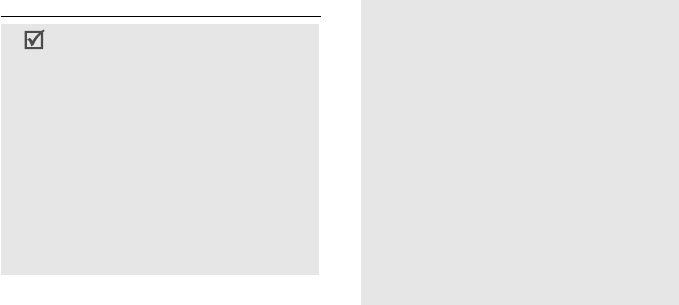
65
FCC Notice and Cautions
•This device complies with Part 15 of the FCC
Rules. Operation is subject to the following
two conditions: (1) this device may not cause
harmful interference, and (2) this device must
accept any interference received, including
interference that may cause undesired
operation.
•This equipment has been tested and found
to comply with the limits for a Class B digital
device, pursuant to part 15 of the FCC Rules.
These limits are designed to provide
reasonable protection against harmful
interference in a residential installation. This
equipment generates, uses and can radiate
radio frequency energy and,
if not installed and used in accordance with the
instructions, may cause harmful interference to
radio communications. However, there is no
guarantee that interference will not occur in a
particular installation. If this equipment does
cause harmful interference to radio or television
reception, which can be determined by turning
the equipment off and on, the user is
encouraged to try to correct the interference by
one or more of the following measures:
-Reorient or relocate the receiving antenna.
-Increase the separation between the equipment
and receiver.
-Connect the equipment into an outlet on a
circuit different from that to which the receiver
is connected.
-Consult the dealer or an experienced radio/TV
technician for help.

Health and safety information
66
The USB dongle may cause TV or radio interference if
used in close proximity to receiving equipment. The FCC
can require you to stop using the USB dongle if such
interference cannot be eliminated.
Vehicles using liquefied petroleum gas (such as propane
or butane) must comply with the National Fire
Protection Standard (NFPA-58). For a copy of this
standard, contact the National Fire Protection
Association, One Battery march Park, Quincy, MA
02269, Attn: Publication Sales Division.
Cautions
Changes or modifications made in the radio USB
dongle, not expressly approved by Samsung, will void
the user’s authority to operate the equipment.
Only use approved batteries, antennas and chargers.
The use of any unauthorized accessories may be
dangerous and void the USB dongle warranty if said
accessories cause damage or a defect to the USB
dongle.
Although your USB dongle is quite sturdy, it is a
complex piece of equipment and can be broken. Avoid
dropping, hitting, bending or sitting on it.
Other Important Safety Information
• Only qualified personnel should service the USB
dongle or install the USB dongle in a vehicle. Faulty
installation or service may be dangerous and may
invalidate any warranty applicable to the device.
• Check regularly that all wireless USB dongle
equipment in your vehicle is mounted and operating
properly.
• Do not store or carry flammable liquids, gases or
explosive materials in the same compartment as the
USB dongle, its parts or accessories.
• For vehicles equipped with an air bag, remember
that an air bag inflates with great force. Do not
place objects, including both installed or portable
wireless equipment in the area over the air bag or in
the air bag deployment area. If wireless equipment

67
is improperly installed and the air bag inflates,
serious injury could result.
• Switch your USB dongle off before boarding an
aircraft. The use of wireless USB dongle in aircraft is
illegal and may be dangerous to the aircraft's
operation.
• Failure to observe these instructions may lead to the
suspension or denial of teleUSB dongle services to
the offender, or legal action, or both.
Product Performance
Getting the Most Out of Your Signal Reception
The quality of each call you make or receive depends on
the signal strength in your area. Your USB dongle
informs you of the current signal strength by displaying
a number of bars next to the signal strength icon. The
more bars displayed, the stronger the signal.
If you're inside a building, being near a window may
give you better reception.
Understanding the Power Save Feature
If your USB dongle is unable to find a signal after 15
minutes of searching, a Power Save feature is
automatically activated. If your USB dongle is active, it
periodically rechecks service availability or you can
check it yourself by pressing any key.
Anytime the Power Save feature is activated, a
message displays on the screen. When a signal is
found, your USB dongle returns to standby mode.
Maintaining Your USB dongle's Peak
Performance
For the best care of your USB dongle, only authorized
personnel should service your USB dongle and
accessories. Faulty service may void the warranty.
There are several simple guidelines to operating your
USB dongle properly and maintaining safe, satisfactory
service.
• Hold the USB dongle with the antenna raised, fully-
extended and over your shoulder.
• Try not to hold, bend or twist the USB dongle's
antenna.

Health and safety information
68
• Don't use the USB dongle if the antenna is
damaged.
• Speak directly into the USB dongle's receiver.
• Avoid exposing your USB dongle and accessories to
rain or liquid spills. If your USB dongle does get wet,
immediately turn the power off and remove the
battery. If it is inoperable, call Customer Care for
service.
Availability of Various Features/Ring
Tones
Many services and features are network dependent and
may require additional subscription and/or usage
charges. Not all features are available for purchase or
use in all areas. Downloadable Ring Tones may be
available at an additional cost. Other conditions and
restrictions may apply. See your service provider for
additional information.
Battery Standby and Talk Time
Standby and talk times will vary depending on USB
dongle usage patterns and conditions. Battery power
consumption depends on factors such as network
configuration, signal strength, operating temperature,
features selected, frequency of calls, and voice, data,
and other application usage patterns.
Battery Precautions
• Never use any charger or battery that is damaged in
any way.
• Use the battery only for its intended purpose.
• If you use the USB dongle near the network's base
station, it uses less power; talk and standby time
are greatly affected by the signal strength on the
cellular network and the parameters set by the
network operator.
• Battery charging time depends on the remaining
battery charge and the type of battery and charger
used. The battery can be charged and discharged

69
hundreds of times, but it will gradually wear out.
When the operation time (talk time and standby
time) is noticeably shorter than normal, it is time to
buy a new battery.
• If left unused, a fully charged battery will discharge
itself over time.
• Use only Samsung-approved batteries and recharge
your battery only with Samsung-approved chargers.
When a charger is not in use, disconnect it from the
power source. Do not leave the battery connected to
a charger for more than a week, since overcharging
may shorten its life.
• Extreme temperatures will affect the charging
capacity of your battery: it may require cooling or
warming first.
• Do not leave the battery in hot or cold places, such
as in a car in summer or winter conditions, as you
will reduce the capacity and lifetime of the battery.
Always try to keep the battery at room temperature.
A USB dongle with a hot or cold battery may
temporarily not work, even when the battery is fully
charged. Li-ion batteries are particularly affected by
temperatures below 0 °C (32 °F).
• Do not short-circuit the battery. Accidental short-
circuiting can occur when a metallic object (coin, clip
or pen) causes a direct connection between the +
and - terminals of the battery (metal strips on the
battery), for example when you carry a spare
battery in a pocket or bag. Short-circuiting the
terminals may damage the battery or the object
causing the short-circuiting.
• Dispose of used batteries in accordance with local
regulations. In some areas, the disposal of batteries
in household or business trash may be prohibited.
For safe disposal options for Li-Ion batteries, contact
your nearest Samsung authorized service center.
Always recycle. Do not dispose of batteries in a fire.
Care and Maintenance
Your USB dongle is a product of superior design and
craftsmanship and should be treated with care. The
suggestions below will help you fulfill any warranty

Health and safety information
70
obligations and allow you to enjoy this product for many
years.
• Keep the USB dongle and all its parts and
accessories out of the reach of small children.
• Keep the USB dongle dry. Precipitation, humidity
and liquids contain minerals that will corrode
electronic circuits.
• Do not use the USB dongle with a wet hand. Doing
so may cause an electric shock to you or damage to
the USB dongle.
• Do not use or store the USB dongle in dusty, dirty
areas, as its moving parts may be damaged.
• Do not store the USB dongle in hot areas. High
temperatures can shorten the life of electronic
devices, damage batteries, and warp or melt certain
plastics.
• Do not store the USB dongle in cold areas. When the
USB dongle warms up to its normal operating
temperature, moisture can form inside the USB
dongle, which may damage the USB dongle's
electronic circuit boards.
• Do not drop, knock or shake the USB dongle. Rough
handling can break internal circuit boards.
• Do not use harsh chemicals, cleaning solvents or
strong detergents to clean the USB dongle. Wipe it
with a soft cloth slightly dampened in a mild soap-
and-water solution.
• Do not paint the USB dongle. Paint can clog the
device's moving parts and prevent proper operation.
• Do not put the USB dongle in or on heating devices,
such as a microwave oven, a stove or a radiator. The
USB dongle may explode when overheated.
• When the USB dongle or battery gets wet, the label
indicating water damage inside the USB dongle
changes color. In this case, USB dongle repairs are
no longer guaranteed by the manufacturer's
warranty, even if the warranty for your USB dongle
has not expired.
• If your USB dongle has a flash or light, do not use it
too close to the eyes of people or animals. This may
cause damage to their eyes.
71
• Use only the supplied or an approved replacement
antenna. Unauthorized antennas or modified
accessories may damage the USB dongle and violate
regulations governing radio devices.
• If the USB dongle, battery, charger or any accessory
is not working properly, take it to your nearest
qualified service facility. The personnel there will
assist you, and if necessary, arrange for service.